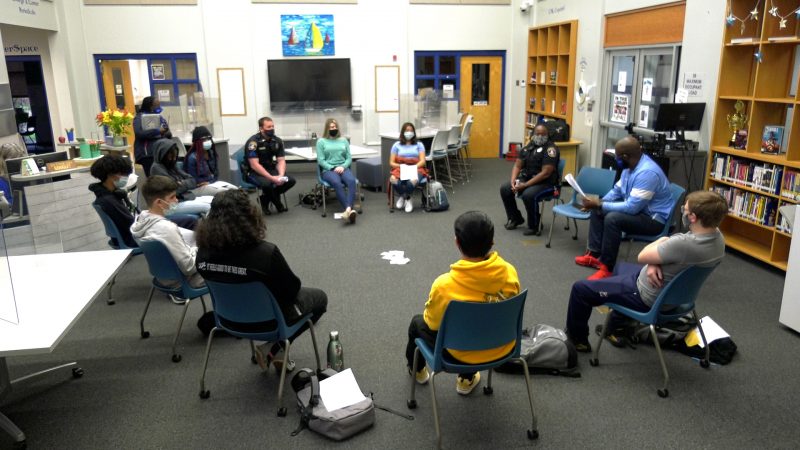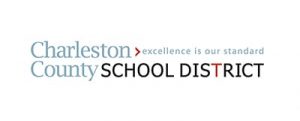Students at St. John’s building relationships with police officers one conversation at a time
March 18, 2021St. John’s High School students are having honest and frank conversations with members of the Charleston Police Department (CPD). These talks, called Community Circles, are part of a department initiative that puts officers in front of Charleston County School District (CCSD) students so that a structured dialogue can be used to bridge the gap between communities and law enforcement.
Master Police Officer Adam Deming is in his fourth year as the School Resource Officer at St. John’s and facilitates the Community Circles. The idea came about last year before COVID-19 shut down schools and before the nation witnessed the death of George Floyd in Minneapolis, Minnesota on May 25. Floyd’s passing was the latest in a series of high-profile killings of unarmed Black people by police in the country.

According to Deming the Community Circles were designed simply to provide a safe place for open discussion where students could ask questions, not just of him but of other police officers as well.
“I wanted the students to come and share and feel that they could be open and comfortable,” said Deming. “There will be instances where a student may interact with law enforcement outside of school and I want them to have a positive experience with the next officer they come in contact with.”
At St. John’s the theme is “stronger together.” Principal Steve Larson believes in giving his students a voice and with this endeavor, he hopes the takeaway is that “we’re all in this together.”
The students in attendance are allowed to participate with parent permission. On average there are about 25 students in attendance and the hope is that the circle will continue to grow.
Working with Director of Student Engagement Theresa Griffith and Instructional Coach Leslie McLaughlin, Deming was able to use the structure of the program to introduce students to his colleagues at the department. The format of the Community Circles follows the school’s belief in restorative practices that addresses the needs of the whole student. There are set expectations of the circle keeper, the students, and the officers.
“We’re creating activists and future leaders,” said Griffith. “We are creating people who will go back into the community, give back, and create change; it’s the types of changes that the kids want.”
McLaughlin added the students can take the skills they are learning through this process to the outside world and use them in their everyday lives.
For St. John’s senior Bruna De Jesus, Community Circles are a safe place to ask questions and have productive dialogue.
De Jesus explained that students pick the topics they want to discuss, prior to each meeting. Those topics range from police brutality, to how officers feel about how society views them, to general policing policies. Not all of the topics are law enforcement related, however. Social media, current events, and typical teenage concerns are also discussed.
“A lot of students had a prior mindset about police officers,” said De Jesus. “As they got to know the officers, their minds changed and they realized these men and women were more than just a uniform or someone in authority. The conversations can be tough but they take place in a respectful way.”
Ofc. Jose Bordallo is Latino and a Johns Island native. He is also the Latin liaison for CPD. Bordallo was chosen to participate in the Community Circle so that he could create connections with the Latino students at St. John’s.
“It’s good for the students to see a Latino officer in uniform serving his community,” said Bordallo. “I am from John’s Island so I am easily able to help provide resources and connections to things the students and their families may need.”
Bordallo said he has witnessed an increased comfort level with the students and teachers.
“The Community Circle has been beneficial because it humanizes us as officers and it shows the students they have access to us, should they need an officer,” said Bordallo.
De Jesus said the experience has been positive for her and she is learning about policy.
“Knowing my rights and the policies that officers and departments must follow makes me feel safe,” said De Jesus. “I know what I should and should not do and being armed with knowledge makes me feel safe.”
CPD Lt. Jeff Harrison described the conversations as restorative because questions are raised, answers are given, and a better understanding is the end result.
The first Community Circle lasted three hours, and according to Harrison, it set the tone for being open and honest.
“We’re seeing barriers being broken down and the students are getting more personal and interactive,” said Harrison. “They are not as guarded and feel like they can ask us anything.”
De Jesus has also formed a bond with SRO Deming and feels empowered to go to him with questions or concerns outside of the Community Circle. She said the experience has allowed her to feel connected to the other officers that participate as well.
“Communication is a great way to de-stigmatize everything,” said De Jesus. “It changes the opinions we may have had growing up.”
Swarkena Foggy, a junior, was nervous at first. After seeing her classmates make the leap and actively participate in the Community Circle, she jumped in with questions of her own.
Foggy said she did not distrust police officers prior to her participation in the Community Circle, but had mixed feelings as she followed the news during and after some notable events in 2020.
Sr. Officer Nicholas Brown said specifically that the students were interested in the riots in Charleston.
“The students wanted to know some of the inner workings of it, our responses, our reactions, and how we felt about it as people,” said Brown. “Policing is one of those things that is multi-faceted. We do a multitude of things that encompasses our community and this is just one of them. We want the kids to see that we are out there working for them and our community.”
“These discussions have given me the confidence to ask the hard questions and stand up for things I believe in,” said Foggy. “As far as the student body, everyone coming together to talk opened a lot of eyes and probably helped expand their connections outside of this school to share with others that all police officers are not bad.”
Sgt. Chris Koegler agreed. He believes that surrounding yourself with people who think differently than you do opens eyes and minds to better understanding.
“The students’ willingness to be up front and get right into it was great to see,” said Koegler. “They tackled the issues head-on and that’s where we wanted it to be.”
MPO Joseph Dela Rosa described the meeting as an environment where no one is being judged and a place where students can be in the company of police officers in a casual setting versus one in which they might be in trouble.
“This is showing me that what I say matters,” said Foggy. “My questions, my thoughts, and my feelings matter. I applaud the officers who are participating and being willing to be put on the spot and answering questions that may be hard to answer.”
Officer Deming and Brown, who have served CPD in a multitude of roles, were recently awarded a commendation from the department for spearheading this initiative.
“This has been a learning experience for the students, staff, and officers,” said Deming. “It has been a positive way to bridge the gap. The open dialogue we have been able to have with these students will hopefully result in them feeling comfortable in coming to me or any other officer with problems, concerns or the need for advice.”
The program has been so successful that it has now expanded to West Ashley High School, Burke High School, James Island Charter High School, and Haut Gap Middle School.
About the Charleston County School District
Charleston County School District (CCSD) is a nationally-accredited school district that is committed to providing equitable and quality educational opportunities for all of its students. CCSD is the second-largest school system in South Carolina and represents a unique blend of urban, suburban, and rural schools spanning 1,300 square miles along the coast. CCSD serves more than 50,000 students in 87 schools and specialized programs.
CCSD offers a diverse, expanding portfolio of options and specialized programs, delivered through neighborhood, magnet, IB (international baccalaureate), Montessori, and charter schools. Options include programs in science, technology, engineering, and mathematics (STEM); music and other creative and performing arts; career and technical preparation programs; and military.













